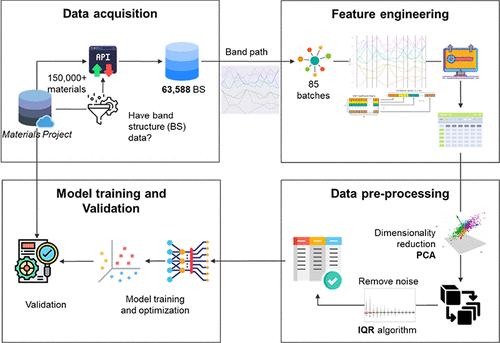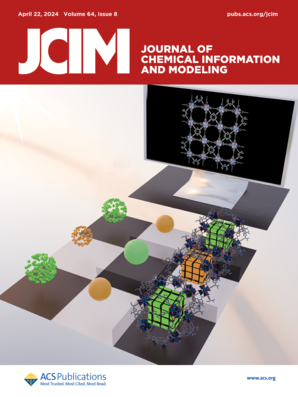机器学习辅助从电子能带结构发现材料
IF 5.6
2区 化学
Q1 CHEMISTRY, MEDICINAL
引用次数: 0
摘要
传统的材料发现方法通常依赖于直觉和试错实验,不仅耗时,而且在有效探索广阔的设计空间方面能力有限。机器学习(ML)是一种强大的模式识别工具,它的出现为材料发现带来了令人兴奋的变革机会。这项研究探索了如何应用 ML 技术,利用带状结构数据协助发现材料。电子能带结构描述了材料中电子的能级,蕴含着有关材料电子和光学特性的重要信息。从材料项目数据库中检索到了 63,588 种材料(包括金属和绝缘体)的带状结构数据。根据第一布里渊区的能带路径,这些数据被分成 85 批。在对带状结构数据进行特征选择和工程设计后,对三种 ML 聚类算法进行了训练,然后进行了降噪处理。通过比较聚类中材料的特性,对模型进行了验证。本文章由计算机程序翻译,如有差异,请以英文原文为准。

Machine-Learning-Assisted Materials Discovery from Electronic Band Structure
Traditional methods of materials discovery, often relying on intuition and trial-and-error experimentation, are time-consuming and limited in their ability to explore the vast design space effectively. The emergence of machine learning (ML) as a powerful tool for pattern recognition has opened exciting opportunities to revolutionize materials discovery. This work explores the application of ML techniques to assist in the discovery of materials using band structure data. The electronic band structure, which describes the energy levels of electrons in a material, holds vital information regarding its electronic and optical properties. The band structure data of 63,588 materials, including metals and insulators, have been retrieved from the Materials Project database. The data were grouped into 85 batches based on the band path in the first Brillouin zone. Three ML clustering algorithms were trained on the band structure data after performing feature selection and engineering, followed by noise reduction. The models were validated by comparing the materials’ properties in a cluster.
求助全文
通过发布文献求助,成功后即可免费获取论文全文。
去求助
来源期刊
CiteScore
9.80
自引率
10.70%
发文量
529
审稿时长
1.4 months
期刊介绍:
The Journal of Chemical Information and Modeling publishes papers reporting new methodology and/or important applications in the fields of chemical informatics and molecular modeling. Specific topics include the representation and computer-based searching of chemical databases, molecular modeling, computer-aided molecular design of new materials, catalysts, or ligands, development of new computational methods or efficient algorithms for chemical software, and biopharmaceutical chemistry including analyses of biological activity and other issues related to drug discovery.
Astute chemists, computer scientists, and information specialists look to this monthly’s insightful research studies, programming innovations, and software reviews to keep current with advances in this integral, multidisciplinary field.
As a subscriber you’ll stay abreast of database search systems, use of graph theory in chemical problems, substructure search systems, pattern recognition and clustering, analysis of chemical and physical data, molecular modeling, graphics and natural language interfaces, bibliometric and citation analysis, and synthesis design and reactions databases.

 求助内容:
求助内容: 应助结果提醒方式:
应助结果提醒方式:


